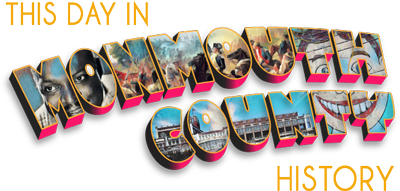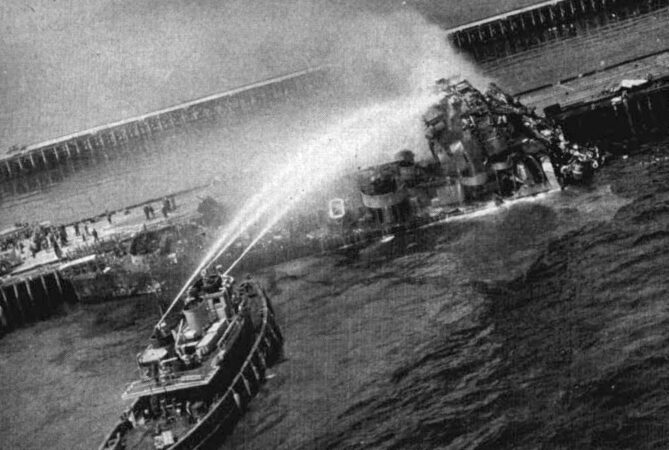On April 30, 1946, the USS Solar, a U.S. Navy Buckley-class destroyer escort (DE 221), exploded at the Navy Pier in Leonardo, killing seven sailors and injuring 125 others.
The Solar was refitted in 1946 to serve as a sonar test vessel. On April 30, she was berthed at Leonardo Pier I of Naval Ammunition Depot Earle on Raritan Bay to discharge ammunition, as her new duties required far fewer munitions than her wartime service. According to reports, the operation went smoothly until shortly after 11:30 a.m. when an anti-submarine depth-charge launcher known as a “hedgehog” exploded in the arms of one of the crew as he was attempting to pass the charge to a truck. (The Navy would claim that the hedgehog, a notoriously unreliable explosive, had been dropped, placing blame on the sailor rather than faulty ordnance.) That crewman escaped with minor injuries; the burns to his chest proved it had exploded in his arms and had not been dropped.
Three ensuing explosions blasted the ship near her number two upper handling rooms. Her number two gun was demolished, and the bridge, main battery director, and mast were all blown aft and to starboard. Both sides of the ship were torn open, and her deck was a mass of flames. The order to abandon ship came after the second explosion and was carried out expeditiously. The blast tore away one-third of the 306-foot ship’s forward structure.
Detonation Rocks Monmouth County, Raritan Bay
The concussion radius was 20 to 30 miles, shaking homes from Staten Island to the interior of Monmouth County. According to The New York Times:
the detonation shook the New Jersey coast in and around the Raritan Bay district, where a number of other vessels were preparing to unload ammunition. It was unofficially estimated here that these vessels held, all told, about 25,000 tons of explosives. Tugs dragged these craft out of the danger zone. Burning fragments from the Solar, hurled at tremendous force against freight cars on the pier, started other explosions. One car in a freight string, filled chiefly with depth charges, blew up and all but vanished in dust and smoke, scattering its parts in all directions. Three strings of rail cars were hauled shoreward by their locomotive crews, at great risk.
Ultimately, seven sailors were killed, and while 125 received injuries, only thirty-five were hospitalized, and of them, only a handful remained overnight for additional treatment. Further casualties had been prevented through heroic actions taken by USS Solar crew members. Lieut. Comdr. G.R. La Rocque of Kankakee, Ill., the Solar’s 27-year-old skipper, who was burned on his face and hands, spoke of the heroism of his enlisted men: “Those sailors were wonderful,” he said. “God, they were brave men. Believe me, I saw a lot of brave sailors. I couldn’t begin to put into words what those men did. It was wonderful. On the starboard side and on the port side, they went into the teeth of the fire to fight it.”
Caught Between the Devil and the Deep Blue Sea
Anthony Nagrosky was a civilian employee at Naval Weapons Station Earle in 1946. He worked as a “joiner,” using lumber to help brace and pack Navy ordnance inside the rail cars used to transport ammunition safely between ship and shore. On April 30, he was working out near the end of the three-mile-long pier. About 1,000 feet away, between him and land, was the USS Solar. When the Solar was rocked by explosions, Nagrosky and the others there found themselves facing a harrowing choice: Dive into the water and attempt to swim three miles to shore, or else try to take cover and hope that luck was on their side as shards of metal flew everywhere.
Someone remembered that a small rowboat, used for pier painting and maintenance, was tied up at the water level near a ladder, and the men were able to get off the pier safely and row to shore. But for a few minutes, it must have seemed like a moment out of the old spiritual ballad,
“Caught Between the Devil and the Deep Blue Sea.”
Joyce Nagrosky, a granddaughter of Anthony Nagrosky, was six years old at the time of the Solar explosion. She remembers being at home in Hazlet with her mother, when they both felt and heard the blast. “We thought it was a bomb,” she said, and they and others around the neighborhood gathered in the street to wonder what was happening. Later, listening to the radio, they would find out.
“It very much affected my grandfather,” she said. “Some of the people he was working with were blown up, and he remembered seeing ‘pieces of people’ that he would never forget.”
Monmouth Timeline is very grateful to Ed Banfield and Joyce Nagrosky, grandchildren of Anthony Nagrosky, for sharing their memories of this amazing story.
Wartime Emergency Planning Saves Lives During Peacetime Disaster
The rapid mobilization of Red Cross emergency forces also helped to minimize injuries. The Disaster Relief Committee of the Monmouth Chapter of the American Red Cross was created during the Second World War in anticipation that the fighting would come to American shores. It was never deployed in wartime. However, within 15 minutes of the USS Solar explosion, two Red Cross nurses and a field director were on the scene at the pier treating wounded sailors. The disaster quickly brought into action 300 more trained Red Cross workers, many of whom worked through the night, both at the Naval Ammunition Depot and the chapter headquarters in Shrewsbury. Red Cross cars, trucks, station wagons, ambulances, and the chapter’s mobile kitchen shuttled back and forth between Shrewsbury and the depot, carrying blood plasma, relief supplies, food, disaster equipment, and personnel.
Later, Earle naval officers expressed astonishment and gratitude for the swift response of rescue units and medical and Red Cross aid. “The Monmouth County Red Cross assembled its membership in record time and got all its rolling stock and other equipment to the station in ample time to be of service. Ambulances and more doctors, nurses and medical attendants than were needed swarmed into the depot from Fort Hancock, Raritan Arsenal and Monmouth County hospitals.”
Ultimately, the experience validated the very purpose and existence of the Earle Navy Pier, three miles long from shore to end. The pier was built to ensure that ammunition stores and the on- and off-loading of arms from ship to shore, and vice versa, would not injure civilians in the event of an explosion, as had occurred in the deadly 1916 explosion at the munitions facility at Black Tom Island in New York Harbor. The Solar disaster also proved the stalwart readiness and capabilities of the Monmouth County Red Cross.
Sources:
Banfield Ed. (2021). Personal conversation with the author.
Berger, Meyer. (1946). Naval Ship Disaster: Warship Blows Up At Munitions Pier In Port, Killing Five. The New York Times, May 1, 1946, P. 1.
Destroyer Escort Sailors Association. Available: https://www.desausa.org/de_photo_library/uss_solar_de_221.htm
Negrosky, Joyce. (2021). Personal conversation with the author.
Featured image credit: USS Solar (DE-221) at the Naval Ammunition Depot Earle, New Jersey (USA), 30 April 1946. U.S. Navy – U.S. Navy All Hands magazine June 1946, p. 40. Created: April 30, 1946. All photographs published in ALL HANDS are official Department of Defense photographs unless otherwise designated, Public Domain.


Love Earle naval base. Grew up next to it. As a little boy I would go into the woods and collect Box Turtles at Earle. There is a very old cemetery in there that was overgrown. I hope it has been preserved.
What ever happened to the large piece of shrapnel that was at the entrance to naval weapons station Earle from the 1946 explosion
I don’t know, I will try and find out.